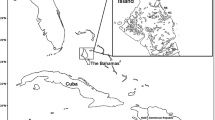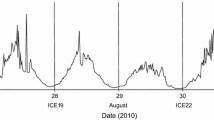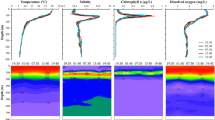Abstract
Marine copepods commonly exhibit vertical movements in the water column over the diel cycle, termed diel vertical migration (DVM), with the most common pattern being an ascent in the water column to minimum depth around sunset and descent to maximum depth around sunrise. The present study characterized the DVM pattern of the pontellid copepod Calanopia americana Dahl in the Newport River estuary (North Carolina, USA, in July 2003). The estuary is shallow and well-mixed, and the study site (34°43′N; 76°40′W), 1.5 km inside the estuary entrance, is unusual in lying within a gyre where tidal currents are always in the seaward direction. Changes in C. americana vertical abundance were related to spectrally relevant changes in light throughout the diel cycle. Simultaneous measurements of light and zooplankton abundance near the surface (0.5 m depth) and near the bottom (0.5 m above bottom) were made over one 4-h period and two 3-day periods during different phases of the tide. These observations suggest that C. americana undertook twilight DVM in the Newport River estuary; an ascent to the surface occurred at sunset, followed by a descent to near the bottom around midnight, with a second ascent to the surface and then descent to near bottom at sunrise. DVM in C. americana was independent of the tidal cycle, with the initial ascent in the water column at sunset possibly associated with relative rates of irradiance change. Copepod vertical movements were consistent with a night-active endogenous rhythm, and appeared independent of the abundance of predatory chaetognaths, Sagitta spp. In DVM studies with migrators like C. americana that are broadly sensitive to visible wavelengths of light, measuring photosynthetically active radiation may be a reasonable alternative to measuring light in a spectrally relevant photometric unit.






Similar content being viewed by others

References
Archer SN (1999) Light and photoreception: visual pigments and photoreception. In: Archer SN, Djamgoz MBA, Loew ER, Vallerga S (eds) Adaptive mechanisms in the ecology of vision. Kluwer, Dordrecht, pp 25–41
Baier CT, Purcell JE (1997) Trophic interactions of chaetognaths, larval fish, and zooplankton in the South Atlantic Bight. Mar Ecol Prog Ser 146:43–53
Boden BP, Kampa EM (1965) An aspect of euphausiid ecology revealed by echo sounding in a fjord. Crustaceana 9:155–173
Boden BP, Kampa EM (1967) The influence of natural light on the vertical migrations of an animal community in the sea. Symp Zool Soc Lond 19:15–26
Bollens SM, Frost BW (1989a) Zooplanktivorous fish and variable diel vertical migration in the marine planktonic copepod Calanus pacificus. Limnol Oceanogr 34:1072–1083
Bollens SM, Frost BW (1989b) Predator-induced diel vertical migration in a planktonic copepod. J Plankton Res 11:1047–1065
Bowman TE (1971) The distribution of calanoid copepods off the southeastern United States between Cape Hatteras and southern Florida. Smithson Contrib Zool 96:1–58
Chatfield C (1989) The analysis of time series: an introduction. Chapman and Hall, New York
Clarke GL (1934) The diurnal migration of copepods in St. Georges Harbor, Bermuda. Biol Bull (Woods Hole) 67:456–460
Cohen JH, Forward RB Jr (2002) Spectral sensitivity of vertically migrating marine copepods. Biol Bull (Woods Hole) 203:307–314
Cohen JH, Forward RB Jr (2005) Diel vertical migration in the marine copepod Calanopia americana. II. Proximate role of exogenous light cues and endogenous rhythms. Mar Biol (in press). DOI 10.1007/s00227-005-1570-4
Cushing DH (1951) The vertical migration of planktonic Crustacea. Biol Rev 26:158–192
Dagg MJ, Frost BW, Newton JA (1997) Vertical migration and feeding behavior of Calanus pacificus females during a phytoplankton bloom in Dabob Bay, U.S. Limnol Oceanogr 42:974–980
Fleminger A (1956) Taxonomic and distributional studies on the epiplankton calanoid copepods (Crustacea) of the Gulf of Mexico. PhD thesis, Department of Biology, Harvard University, Boston
Forward RB Jr (1985) Behavioral responses of larvae of the crab Rhithropanopeus harrisii (Brachyura: Xanthidae) during diel vertical migration. Mar Biol 90:9–18
Forward RB Jr (1988) Diel vertical migration: zooplankton photobiology and behavior. Oceanogr Mar Biol Annu Rev 26:361–393
Forward RB Jr, Tankersley RA (2001) Selective tidal stream transport of marine animals. Oceanogr Mar Biol Annu Rev 39:305–353
Frank TM, Widder EA (1997) The correlation of downwelling irradiance and staggered vertical migration patterns of zooplankton in Wilkinson Basin, Gulf of Maine. J Plankton Res 19:1975–1991
Frank TM, Widder EA (2002) Effects of a decrease in downwelling irradiance on the daytime vertical distribution patterns of zooplankton and micronekton. Mar Biol 140:1181–1193
Gal G, Loew ER, Rudstam LG, Mohammadian AM (1999) Light and diel vertical migration: spectral sensitivity and light avoidance by Mysis relicta. Can J Fish Aquat Sci 56:311–322
Haney JF (1988) Diel patterns of zooplankton behavior. Bull Mar Sci 43:583–603
Hough AR, Naylor E (1992) Endogenous rhythms of circatidal swimming activity in the estuarine copepod Eurytemora affinis (Poppe). J Exp Mar Biol Ecol 161:27–32
Hutchinson GE (1967) A treatise on limnology: introduction to lake biology and the limnoplankton. Wiley, New York
Kimmerer WJ, Burau JR, Bennett WA (1998) Tidally oriented vertical migration and position maintenance of zooplankton in a temperate estuary. Limnol Oceanogr 43:1697–1709
Kimmerer WJ, Burau JR, Bennett WA (2002) Persistence of tidally-oriented vertical migration by zooplankton in a temperate estuary. Estuaries 25:359–371
Levine J, Funes P, Dowse H, Hall J (2002) Signal analysis of behavioral and molecular cycles. BMC Neurosci 3:1–25
Longhurst AR, Harrison WG (1989) The biological pump: profiles of plankton production and consumption in the upper ocean. Prog Oceanogr 22:47–123
McFarland W, Wahl C, Suchanek T, McAlary F (1999) The behavior of animals around twilight with emphasis on coral reef communities. In: Archer SN, Djamgoz MBA, Loew ER, Vallerga S (eds) Adaptive mechanisms in the ecology of vision. Kluwer, Dordrecht, pp 583–628
Michel HB (1984) Chaetognatha of the Caribbean Sea and adjacent areas. NOAA Tech Rep NMFS 15
Neill WE (1992) Population variation in the ontogeny of predator-induced vertical migration of copepods. Nature 356:54–57
Ohman MD (1990) The demographic benefits of diel vertical migration by zooplankton. Ecol Monogr 60:257–281
Ohman MD, Frost BW, Cohen EB (1983) Reverse diel vertical migration: an escape from invertebrate predators. Science 220:1404–1407
Omori M, Fleminger A (1976) Laboratory methods for processing crustacean zooplankton. In: Steedman HF (ed) Zooplankton fixation and preservation. UNESCO, Paris, pp 281–286
Pearre S Jr (1979) Problems of detection and interpretation of vertical migration. J Plankton Res 1:29–44
Pearre S Jr (2003) Eat and run? The hunger/satiation hypothesis in vertical migration: history, evidence and consequences. Biol Rev 78:1–79
Rawlinson KA, Davenport J, Barnes DKA (2004) Vertical migration strategies with respect to advection and stratification in a semi-enclosed lough: a comparison of mero- and holozooplankton. Mar Biol 144:935–946
Ringelberg J (1964) The positively phototactic reaction of Daphnia magna Strauss: a contribution to the understanding of diel vertical migration. Neth J Sea Res 2:319–406
Ringelberg J (1995) Changes in light intensity and diel vertical migration: a comparison of marine and freshwater environments. J Mar Biol Assoc UK 75:15–25
Ringelberg J (1999) The photobehavior of Daphnia spp. as a model to explain diel vertical migration in zooplankton. Biol Rev 74:397–423
Ringelberg J, Flik BJG (1994) Increased phototaxis in the field leads to enhanced diel vertical migration. Limnol Oceanogr 39:1855–1864
Stearns DE (1983) Control of nocturnal vertical migration in the calanoid copepod Acartia tonsa Dana in the Newport River Estuary, North Carolina. PhD thesis, Department of Zoology, Duke University, Durham
Stearns DE, Forward RB Jr (1984) Copepod photobehavior in a simulated natural light environment and its relation to nocturnal vertical migration. Mar Biol 82:91–100
Turner JT, Collard SB, Wright JC, Mitchell DV, Steele P (1979) Summer distribution of pontellid copepods in the neuston of the eastern Gulf of Mexico continental shelf. Bull Mar Sci 29:287–297
Weinberg S (1976) Submarine daylight and ecology. Mar Biol 37:291–304
Widder EA, Frank TM (2001) The speed of an isolume: a shrimp’s eye view. Mar Biol 138:669–677
Wing SR, Largier JL, Botsford LW, Quinn JF (1995) Settlement and transport of benthic invertebrates in an intermittent upwelling region. Limnol Oceanogr 40:316–329
Woolridge T, Erasmus T (1980) Utilization of tidal currents by estuarine zooplankton. Estuar Coast Mar Sci 11:107–114
Zaret TM, Suffern JS (1976) Vertical migration in zooplankton as a predator avoidance mechanism. Limnol Oceanogr 21:804–813
Acknowledgements
We thank E. Sinkhorn for her technical assistance, and R. Barber, S. Johnsen, D. Rittschof, and D. Steinberg for comments on an earlier draft of the manuscript. This material is based in part on research supported by the National Oceanic and Atmospheric Administration (ECOHAB grant NA17OP2725 to R. Forward and P. Tester), with additional funding provided by the Oak Foundation.
Author information
Authors and Affiliations
Corresponding author
Additional information
Communicated by J.P. Grassle, New Brunswick
Electronic Supplementary Material
Rights and permissions
About this article
Cite this article
Cohen, J.H., Forward, R.B. Diel vertical migration of the marine copepod Calanopia americana. I. Twilight DVM and its relationship to the diel light cycle. Marine Biology 147, 387–398 (2005). https://doi.org/10.1007/s00227-005-1569-x
Received:
Accepted:
Published:
Issue Date:
DOI: https://doi.org/10.1007/s00227-005-1569-x



